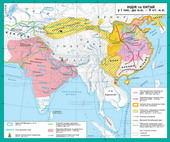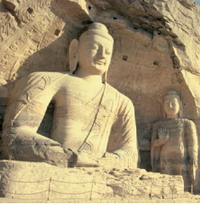Topic 5. Ancient India and China
§ 23. Ancient India
1. Geographical location and natural conditions of ancient India
In South Asia,Peninsula HindustanWas located at largecountry - ancient India. Now in its territory there are five states -India, Pakistan, Nepal, Bangladesh, Sri Lanka. Indian Shores on the west, eastand on the south washed by the Indian Ocean. Bengal and Arabian Seabay. In the north country is surrounded by the largest and highest mountain in the worldspine - the Himalayas, which separated India from other countries. Onlynorthwest India lay in the old way of it to other countries.
Nature India struck by its splendor and diversity. Already in ancienttimes looked to India as a country of miracles. There are many tropical forests, steppes areand desert. Most of the peninsula Hindustan takesplateau, rich in deposits of copper and iron. In the Himalayan mountains areTop two great rivers of India - Ganga, which flows east and the Indus, which flowsevent. When the south wind driven rain clouds from the ocean, mountains stop them. Sotwo whole months of the year - July and August - in India rains and riversout from the coast. In another season rains are rare. In the valleysrivers, especially the Ganges, were very fertile soils.
India is located close to the equator, so most of the year is hot.Himalayas prevent cold north winds penetrate. Great in India,especially the Ganges valley, covered with evergreen rain forest - a jungle. Ofdense foliage, even at night there is dark. Branches of trees obvyti Lian, whozvishuyutsya down, giving no chance to pass through the forest. It was known for some tigers, panthers,Elephants, bears, buffaloes, rhinos, leopards, monkeys. Snakes were crawling along the ground:huge python, poisonous cobras and vipers. In many jungle vodylosyainsect bites some of them were fatal.
2. The oldest city of India
Indian Territory was inhabited from very ancient times. The oldest populationIndia has created a distinctive culture. As a result of excavations revealedremains of two large cities that built the exact plan they called Mohenjo-Daro та
Harappa. They were founded in III thousand BCon the banks of the Indus River.
Of particular interest are the ruins of ancient cities Mohenjo-Daro.The wide and long street stretching from north to south. they crossed the other,that went from west to east. The width of the streets reached 10 m. They perehreschuvalysat right angles. Obviously, in used motor vehicles. OnCrossroads rounded corners of buildings so as not to obstruct the street movement.
Streets were built bi- or threehouses of baked bricks. Each of them was the inner court. Therecooked.
Fire bred in the cavity, which imposed a brick. In the courtsSupervision found, it indicates that there were kept cattle. The lower floor placedkitchen, well, space for storage purposes. Almost every housewas equipped with a shower and dressing room. Used water flows In the citydrain. On the second floor were living rooms. Buildings wereflat roofs with tamped earth them to relax or sleep, ifnight was choking. In addition to residential buildings in town were eatery, shop,warehouses, workshops. In the center stood a fortified citadel surrounded by wallstowers. They arranged a large swimming pool for ritual ablutions.
3. Facilities oldest cities in India
High development in cities has reached the craft of bronzemade tools and weapons, and statues of humans and animals.Archeological found many ornaments of gold, silver, copper and bronze: bracelets,rings, earrings. From a stone hand mill made, different kinds of weights.
High development reached pottery. Almost allware produced on a potter's wheel. Often painted tableware patternsand ornament. In the potter's wheel and made earthenware sewer pipeearthenware wheel lock.
Residents of cities also held domestic animals: cows, sheep, pigs, short-Bulls, humpback zebu bulls, buffaloes, goats, dogs, perhaps tame elephants.With poultry kept chickens and peacocks.
Ancient Indians grew wheat, barley, peas,melons, sugar cane, rice, cotton and others. Made of cotton yarn andtissue. Also enjoyed the fruits of date palm tree. Soil treated withthrough a very rough plow. During the harvest used copper sickles. Residentsancient cities of hunting and fishing.
Moved to the old two-wheel carts Indians, harnessed bulls. Onwater floated in boats and sailing ships.
In cities conducted a livelytrade. The inhabitants of ancient cities traded with South India, Persia,Central Asia, the second anniversary. Be exported cotton cloth, gold, ivory,valuable timber. And bought metals, gems and more.
Already in the third thousand BC Indians had writtenof characters. But read their inscriptions so far failed, because they are all veryshort and the language on which the inscription, we know almost nothing about. Archeological wasfound earthenware inkstand. Therefore we can assume that material forwriting served cloth, bark, or anything else that is not kept to this day.
In the early second millennium BCresidents have to leave their city, they eventually fell into decay, and they skidded sand.About the city forgot to 3,5 thousand years, until in 1922 did not find themarchaeologists. Historians still not established causes of neglect of these cities.You may be epidemic malaria, sudden change of environmental conditions (environmentaldisaster), etc..
Loss of these two citiesends with the oldest period of history of India.
4. Tribes of Aryans
In the middle of thousands II BC in India from the northevent came tribes Aryans. Theysemi-led lifestyle. Coming into a new area, settled on ariasit for a short time. There they built fortified villages, planted barley andwheat fields in the vicinity of cattle grazed. When the pastures and fields vysnazhuvalys,they go to other lands. Sacred animals in Aryans were horse andcow. Aryans in skin lighter than the old Indians.
At the head of the tribe was the leader - Raja. His powerlimited to tribal council. Tribes often united in tribal alliances.
Where did they come to India to find out failed. SomeScientists believe that the original Aryans homeland was somewhere northfrom the Black Sea (in present-day steppe of Ukraine). From there, a fewthousand years ago they came out with their flocks and wandered alone aftersettled in the territory of modern Iran and the Indus river and othermastered Europe. But this is only one version, which keeps a large proportionscientists.
Language Aryans - Sanskrit - is related to the ancient languagePersians and modern European languages: Ukrainian, Russian, Belarusian,English, French and others. All they belong to the Indo-European languagegroup.
This similarity is observed in several words: Matar - Mother (mother) bhratar-brother sunu - son madhu - Honey ahnim- Fire vadar - Water, nabhas- Sky, etc. "Two, three, four, five" in Aryanwould be: "Two, tri, chatur,
Pancha. You can find whole sentences thatsound close to the Ukrainian (Russian, Byelorussian) in Sanskrit.For example:Matar, madhu
ме dehi"Means:"Mom, give me honey." This similarity of language led scientists to concludethat Aryans were the ancestors of many ancient and modern peoples: Persians,Medes, Tajiks, residents of North India and Europe. Arias honoredmany gods and told them about all sorts of myths.
God himself was considered a fire, they called it Ahmi. Mithras was the sun god,who sees everything. It turned with the words: "You - eye of the gods."When arias agreed among themselves, the witnesses called in Mithras.Gods and himself Mithras cheater or punish the offendercontract. King of the gods, the god of storms and lightning - Indra.Aryan warriors during the battle just turned to him, pleading for victory. After Indra - A great warrior who destroyed the Aryan enemies. Godthe sky was Varuna. Arias gradually settled throughoutIndia. They go to the sedentary lifestyle. It also helped thatIndians learned to make tools from iron. It was easier toclear jungle, drain swamps, build channels. Turning toagriculture and residential, arias mixed with the local population and formed togetherIndian people with him.
In the VIII century. BC there are many in IndiaPrincipality and the state.
5. State Maur'ya and its history
By Article VI. BC Northern India was divided intomany kingdoms. Over time, one of them – Magadh - Quickly strengthened and broadened.
Approximately 330 BC general Alexander Macedonian captured the Western India.The liberation movement against the invaders headed Chandragupta,kind of Maur'yiv. He destroyed the built Alexander Macedon fortress. Over time Chandragupta returned to Magadhand took the throne. He was the founder of a powerful state Maur'ya.its capital - the city Pataliputra.
Chandragupta managed to unite the northern and centralIndia.
Grandson Chandragupta Ashoka conquered neighboring kingdoms in southern India. Hugestate Maur'ya cover almost all of India byexcept southernmost its surroundings. IndianTransfer attribute Ashotsi large constructionactivities, expansion of irrigation works and the foundation in many citieshospitals. The state was divided into several major areas, which stood at the headmembers of the royal family. Thus, in the middle of the III century. BCThe Indian government made great power and prosperity.
Ashoka sought to make the population of their country one people. But thisKing union has failed. Most Indians considered themselves members offirst of all their tribes, and only then - the servants of kings Maur'ya.Therefore the government Maur'ya was short-lived. Already in the II century.BC she broke up. Fragmented and weak India become new preyconquerors.
Questions and Tasks
1. What were the environmental conditions of ancient India? Whatresidents had to overcome difficulties of this country?
2. As two scholars called the oldest city in the valley of the riverInd? What reasons could cause a decline in the Ancient Cities II thousand. BC?
3. Compare thousands of India III BC with the second anniversary of the Egypt andsame era. What can you conclude?
4. Identify the main achievements of ancient civilizationIndia.
5. When the Aryans invaded India?
6. What are the common and different lifestyle inAryans economy and population Mohenjo-Daro?
7. Spread the religion of Aryans.
8. When and under what circumstances the government took Maur'ya?Who was its founder?
9. What marked the reign of King Asoka?
10. What causes death of the country Maur'ya?
 English
English

























